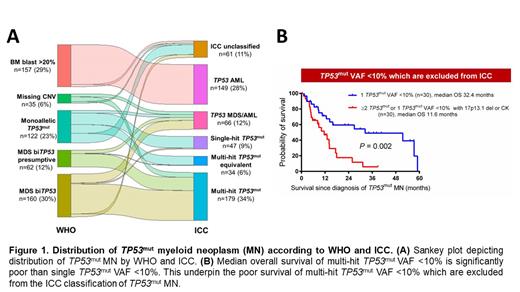BACKGROUND: Recently proposed World Health Organization (WHO, 5 th edition) and International Consensus Classification (ICC) recognized myeloid neoplasms (MN) harboring TP53-mutated ( TP53mut) as a separate entity. However, there are critical differences between the two classifications regarding allelic-status, variance allele frequency (VAF) cut-off and blast categories, that may lead to under- or overestimation of the risk.
METHODS: We analyzed MN harboring TP53mut (VAF ≥2%, n=536) managed at Mayo Clinic (USA) and South Australia Health Network (Australia). ICC (Arber et al, Blood 2022) and WHO (Bluebook, Beta v2) definitions were used to stratify MN harboring TP53mut.
RESULTS: Of 536 cases, 379 (71%) had myelodysplastic syndromes (MDS) (<20% blasts) and 157 (29%) had acute myeloid leukemia (AML). Using WHO, 160 (42%) of 379 were classified as MDS-bi TP53 as they harbored 2 TP53mut (n=115; 30%) or 1 TP53mut plus confirmed loss of heterozygosity (LOH) or copy neutral LOH (cnLOH) of TP53 locus (n=45; 12%). Sixty-two (16%) TP53mut MDS with VAF >49% were classified as presumptive MDS-bi TP53. Of the 157 cases with 1 TP53mut VAF ≤49%, 17 confirmed to have an intact wild-type TP53 copy and were classified as monoallelic. While 140 (89%) cases did not have copy number variation (CNV) analysis.
We next evaluated the number of TP53mut cases classified differently by WHO and ICC. As WHO does not recognize TP53mut AML as a separate entity, 157 (29%) TP53mut AML were not classifiable. 46% (174/379) of the TP53mut MDS including 48 (30%), 12 (19%) and 79 (65%) of bi TP53, presumptive bi TP53 and monoallelic TP53mut MDS according to WHO were classified differently by ICC ( Figure 1A). Discordance between the two classifications were predominantly driven by:
(i) The difference in VAF cut-off. Sixty patients (11%) with TP53mut VAF <10% were excluded from the ICC classification of TP53mut MN as it mandates TP53mut VAF cut-off ≥10%. 11 (18%) and 41 (68%) of these had bi TP53, monoallelic TP53mut MDS by WHO criteria while 8 (13%) had AML. Importantly, within the VAF <10% cohort, median overall survival (OS) of 2 TP53mut or 1 TP53mut with 17p13.1 (hereafter 17p) deletion or complex karyotype (CK, n=30) was significantly poor compared to 1 TP53mut VAF <10% (11.6 vs 32.4 months; P =0.002, Figure 1B), suggesting that ICC may underestimate the poor prognosis of multi-hit or multi-hit equivalent TP53mut MN with VAF <10%.
(ii) The difference in bone marrow blast cut-off. The underlying assumption by WHO is that prognosis of bi TP53mut MDS is poor irrespective of blast percentage category (0-9% vs 10-19%). In contrast, ICC considers that TP53mut MDS/AML (blasts 10-19%) is associated with poor prognosis irrespective of TP53 allelic status. Median OS of TP53mut MDS with 10-19% blasts was significantly poor compared to blast 0-9% (6.4 vs 11.6 months, P <0.0001). Second, median OS of bi TP53mut was significantly poor than monoallelic TP53mut in MDS- blast 0-9% (10.1 vs 15.9 months; P =0.0001) but not in blasts 10-19% (6.8 vs 6.2 months; P =0.19). Hence, exclusion of monoallelic TP53mut MDS with blast 10-19% as TP53mut MN from the WHO classification may underestimate the poor prognosis.
(iii) The difference in the definition of biallelic and multi-hit TP53 loss. 35 cases with 1 TP53mut VAF ≤49%, had 17p deletion but did not have CNV analysis to confirm the loss of TP53 locus and could not be classified further using WHO. ICC classified 18 (50%) of these cases as multi-hit. Median OS of 1 TP53mut VAF ≤49%, and 17p deletion on karyotype was significantly poor than 1 TP53mut (VAF ≤49%without 17p deletion on karyotype (6.4 vs 14.6 months, P =0.001).
(iv) The difference in the definition of multi-hit equivalent. 32% (33/104) WHO defined monoallelic cases without available CNV data, were classified as multi-hit-equivalent by ICC as they harbored CK. However, WHO does not consider CK as presumptive evidence of bi TP53. Median OS of 1 TP53mut VAF ≤49% with CK was significantly poor compared to 1 TP53mut without CK (8.2 vs 26.9 months, P =0.0008).
CONCLUSION: Our study provides evidence that poor prognosis of ‘multi-hit’ TP53 with VAF <10% is underestimated by ICC. On the other hand, poor prognosis of monoallelic TP53 MDS with 10-19% blasts as well as 1 TP53mut VAF ≤49% in the presence of CK is underestimated by WHO. These data suggest that both classifications can be further refined.
Disclosures
Shah:Astellas: Research Funding; MRKR Therapeutics: Research Funding; Celgene: Research Funding; AbbVie: Research Funding. Begna:Immunogen: Research Funding; Novartis: Membership on an entity's Board of Directors or advisory committees; MEI Pharma: Research Funding. Yeung:BMS: Research Funding; Takeda: Honoraria, Membership on an entity's Board of Directors or advisory committees; Amgen: Honoraria, Membership on an entity's Board of Directors or advisory committees, Research Funding; Pfizer: Honoraria, Membership on an entity's Board of Directors or advisory committees; Novartis: Honoraria, Membership on an entity's Board of Directors or advisory committees, Research Funding. Patnaik:StemLine: Research Funding; CTI Pharmaceuticals: Membership on an entity's Board of Directors or advisory committees; Kura Oncology: Research Funding. Foran:CTI: Membership on an entity's Board of Directors or advisory committees; NCI: Membership on an entity's Board of Directors or advisory committees; BeiGene: Membership on an entity's Board of Directors or advisory committees; BMS: Membership on an entity's Board of Directors or advisory committees; Actinium: Research Funding; Kura: Research Funding; Sellas: Research Funding; Roivant: Research Funding; Novartis: Research Funding; Celgene: Research Funding; Astellas: Research Funding. He:Kura Oncology, Inc: Consultancy. Alkhateeb:Mayo Clinic: Current Employment.


This feature is available to Subscribers Only
Sign In or Create an Account Close Modal